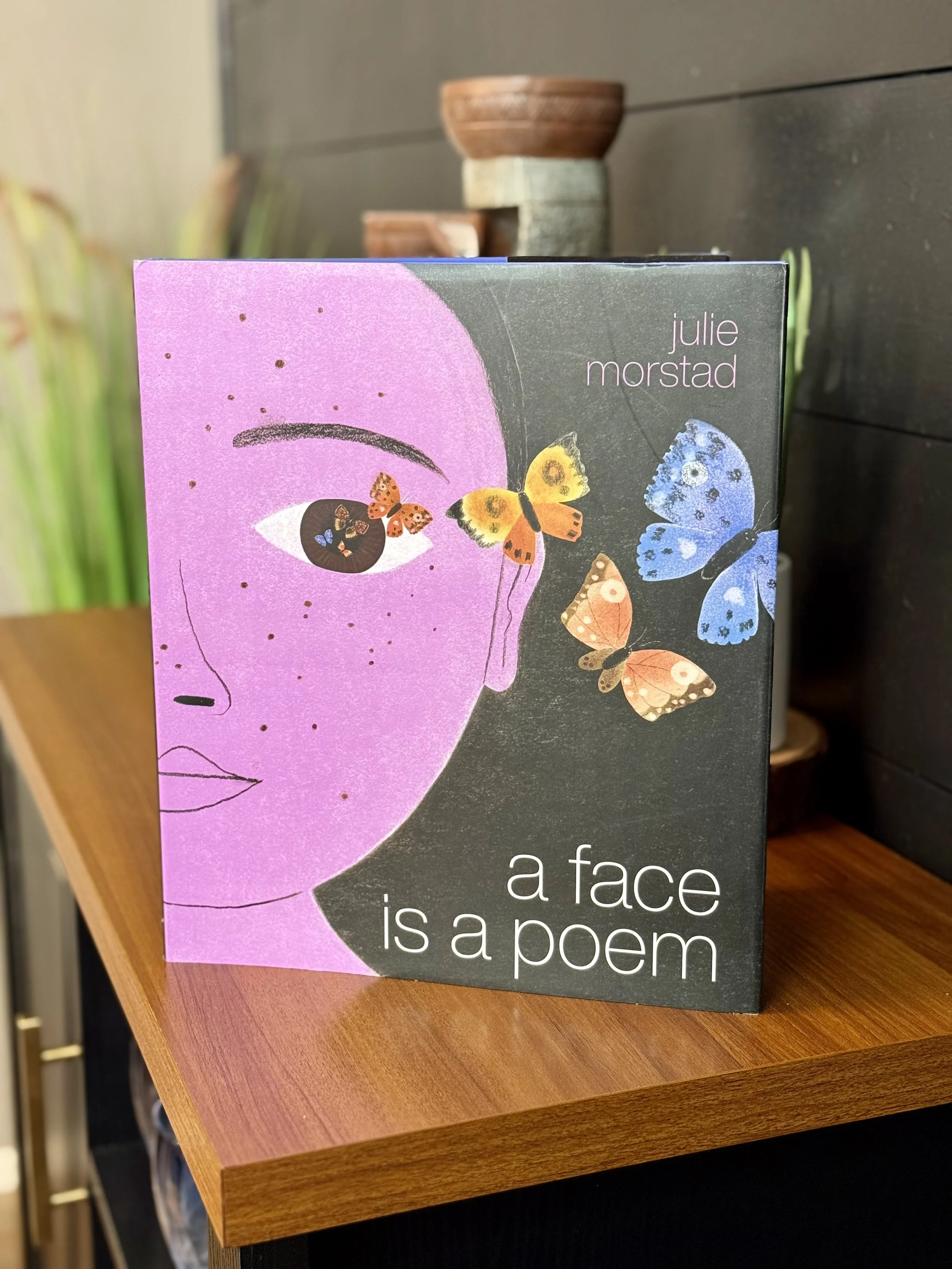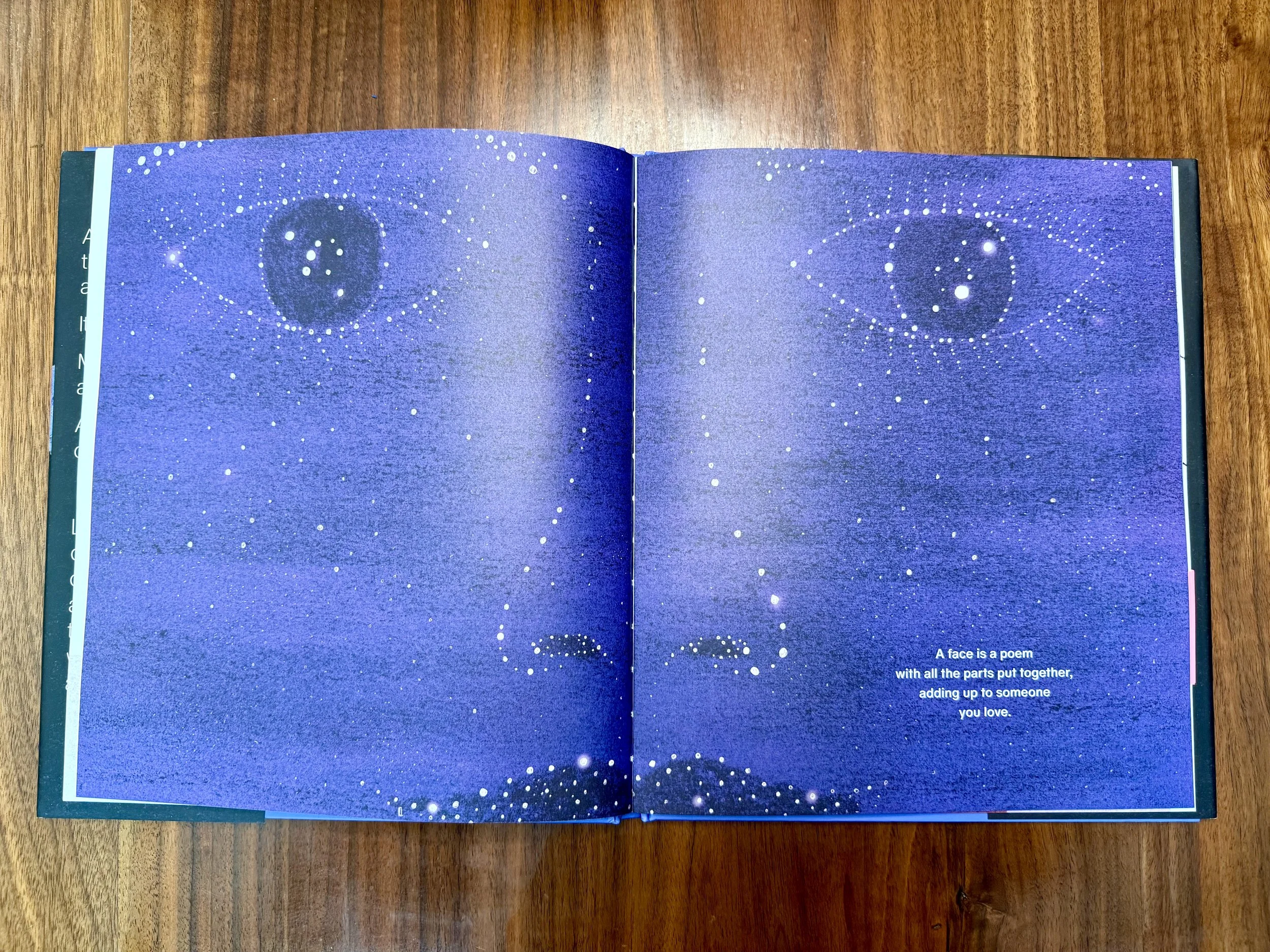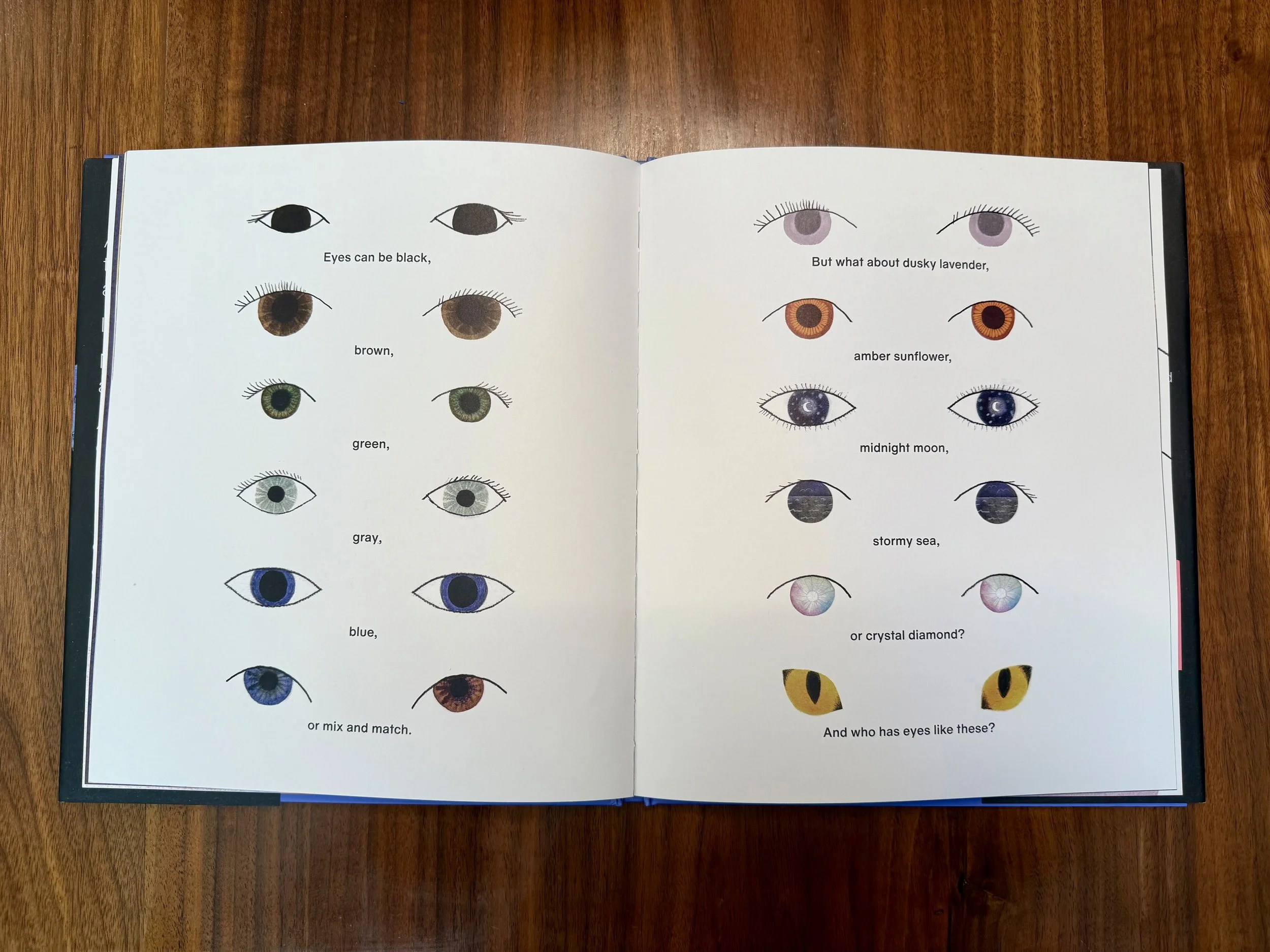Seeing Ourselves in Metaphor: Journaling with A Face is a Poem
Disclosure: Writing Mindset only endorses things that I’ve personally used, something similar, or come highly recommended by trusted peers. If you grab anything I mention using a referral link, I may get a small commission. However, there’s no extra cost to you. If you would like to learn more, please visit the privacy policy and disclosure page.
Julie Morstad’s picture book A Face is a Poem offers readers a playful and poetic way of seeing something familiar—our own faces. Instead of describing features literally, Morstad leans on metaphor: freckles as sprinkles, flowery faces, faces that you find in the clouds. Each page invites readers to view the ordinary as extraordinary. I actually paused in the bookstore when I saw the cover of this book because the colors and imagery were so beautiful.
For writers, this text is a gift. It reminds us that description doesn’t have to be technical—it can be imaginative, metaphorical, and deeply personal. For journalers, it opens the door to self-reflection and self-expression through the lens of poetry. This post serves as a how-to guide for using this text in multiple ways: in the classroom, at home, or within your own notebook.
In this post, you can find…
Tips for using this book as a mentor text for writing
Ways to use the book with preschoolers, grades k-5, grades 6-8, grades 9-12, and for disciplinary literacy projects
Journaling prompts linked to the book (including nature journaling)
One grammar exercise to access grammar instruction
Using A Face is a Poem as a Mentor Text
This mentor text was chosen for its celebration of individuality and self-expression, showing writers how poetry can explore identity, emotion, and personal experience in a concise and powerful way. Its inventive language and playful structure make it an excellent example for teaching figurative language, voice, and poetic techniques, while also encouraging young writers to see their own experiences and characteristics as meaningful material for creative writing.
When reading Morstad’s book, notice how she:
Uses metaphor freely – A nose isn’t just a nose; it’s something else entirely.
Finds beauty in variety – Every face is different, and every difference is celebrated.
Keeps language simple but layered – The comparisons are easy to understand, but they resonate deeply.
Balances image and text – The illustrations show her metaphors in action, making them even more vivid.
As a mentor text, A Face is a Poem encourages us to think about how we describe ourselves and others. What happens when we shift from literal detail to metaphor?
Journaling Prompt: “My Face is a Poem”
Open your journal and try this exercise:
Start with one feature at a time.
My eyes are…
My hair is…
My smile is…
My hands are…
Replace description with metaphor.
My eyes are two windows opening to stories untold.
My hair is a field of grass tangled by the wind.
My smile is a lantern glowing in the dark.
Expand beyond the face. You might describe your whole self as a poem—or choose one feature that tells a bigger story.
Why This Works
Metaphor allows us to see ourselves more tenderly. It moves us away from judgment and toward appreciation. Journaling in this way is not about accuracy—it’s about creativity, perspective, and joy. By turning our features into poetry, we remind ourselves that being human is art.
👉 Try it today: Write a page in your journal beginning with “My face is a poem…” and let your imagination lead.
When I tried this with my own writing, I set up a circle map and divided it into four sections. You could choose any part of the face or body, but I focused on the eyes, smile, hands, and hair. After pairing this activity with Jessica Urlichs’ poem “Finding Me in You” and the Emily Dickinson quote, “I am out with lanterns, looking for myself,” here are some of my favorite lines from my notebook:
I looked in the mirror one morning and wondered
where I had gone.
small grays sprouting,
smile lines now stay put,
brown eyes tired and looking.
Then, you came in and interrupted the inspection
to say, “Hi, mom!”
The first greeting is always the
most important.
After I took you in my arms and pulled back,
there she was.
crown of curls,
same crooked smile,
eyes bright with ideas and opinions.
I’ve spent all this time searching for who I thought
I was going to be,
and this tiny version of my soul
gets to stand beside me each day as a reminder:
“I love you just the way you are.”
For Educators: Bringing A Face is a Poem into the Classroom
Preschool Literacy Connections
With young learners, this book invites curiosity and language play. Focus on noticing and naming—eyes, hair, smiles, and emotions—while modeling simple metaphors aloud.
Invite children to draw their faces and add words or colors that show how they feel.
Use phrases like, “My eyes are bright like sunshine,” or “My hair is soft like a kitten.”
Connect this to identity and belonging, emphasizing that every face is beautiful and unique.
Grades K–5
Elementary students can build on the metaphor concept by combining art and writing.
After reading, ask students to write a short poem or descriptive paragraph using at least one metaphor about themselves.
Have them illustrate their metaphors, turning the page into a self-portrait poem.
Discuss how authors use comparison to create voice and imagery, helping students connect figurative language to emotions and self-awareness.
Grades 6–8
Middle schoolers can use A Face is a Poem to explore identity and personal narrative.
Begin with a quick-write: “When I look in the mirror, I see…”
Move toward metaphor: “When I look in the mirror, I see a storm / a sunrise / a map of memories.”
Guide students in revising literal lines into figurative ones.
This activity supports both ELA standards and social-emotional learning, encouraging confidence and empathy through creative language.
Grades 9–12
For older students, use the text to launch discussions about voice, tone, and self-representation.
Pair A Face is a Poem with other identity poems (e.g., Naomi Shihab Nye’s “Famous” or José Olivarez’s “Ode to My Hair”).
Ask students to analyze how metaphor builds meaning, then write their own reflective poems.
Extend the lesson into visual journaling—students create mixed-media self-portraits using lines from their poems.
This approach blends creative writing, art, and critical analysis, showing how metaphor shapes understanding of self and society.
Disciplinary Literacy Connections
A Face is a Poem isn’t just for language arts—it’s a cross-curricular opportunity for creative thinking.
Science: Describe an organism or system using metaphor (A plant is a quiet architect).
Social Studies: Write about a historical figure through figurative language (Her courage was a rising tide).
Math: Turn a process into metaphor (An equation is a puzzle with hidden harmony).
Art: Design self-portraits with metaphorical captions that show both appearance and personality.
By weaving metaphor into different subjects, students learn to think deeply, observe closely, and express ideas in imaginative ways.
Grammar Focus: Sentence-Level Craft
Skill Focus: Using Appositives for Layered Description
The book offers many examples that can help students learn different parts of writing; however, the last line of the book lends to learning about appositives.
Appositive-a noun or pronoun that renames or explains another name or pronoun, providing additional information.
The key here in the classroom is additional information. I like to start by explaining this as bonus information. It gives even more information than what is expected at first. I like to also highlight the key passage from the mentor text and show connected examples.
From the book: “One thing that won’t change, though: a face is to love.
Specific examples for writers:
One thing that stays the same, a face, a reflection of who we are.
One thing that remains constant, a face, a reminder of our uniqueness.
One thing that never changes, a face, a story we carry with us.
Other examples using the same setup:
My eyes, two quiet pools of memory, hold stories I haven’t told.
My hair, a map of the seasons, curls with every change in weather.
Nature Journaling Connection
Connect A Face is a Poem to nature journaling by blending human and natural metaphors.
Encourage reflection on how we mirror the natural world:
My freckles are constellations of summer.
My heartbeat is a river’s pulse.
Take this journaling practice outside—observe your surroundings, then write a few lines connecting your own features or emotions to what you see in nature.
Additional Journal Prompts for Wellness
Journaling with metaphor can nurture emotional awareness and self-compassion. Try these prompts for mindful reflection:
“Today, my heart feels like…”
“My energy is shaped like…”
“If my week were a season, it would be…”
“The light inside me glows when…”
Final Thought:
When we see ourselves in metaphor, we honor creativity as reflection. A Face is a Poem reminds us that writing isn’t only about describing the world—it’s about understanding our place in it. Whether in the classroom or in your personal journal, this practice is a gentle invitation to look closer, imagine boldly, and write from the heart.







